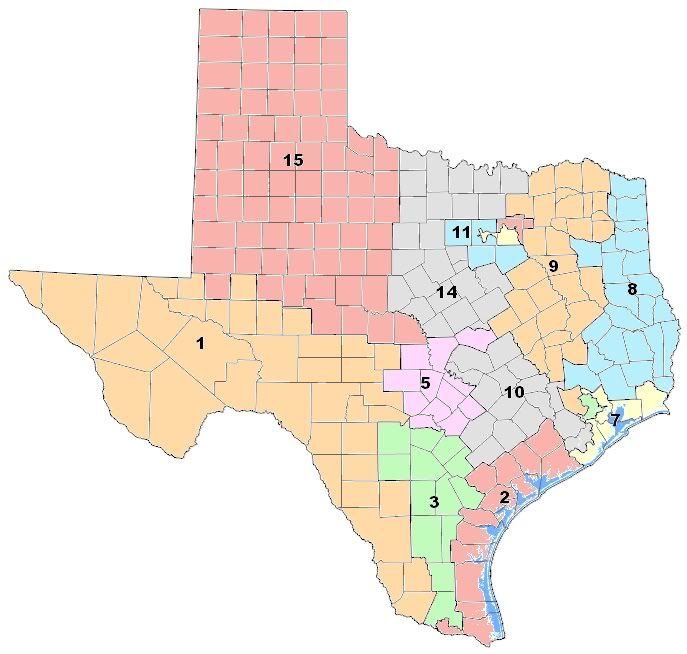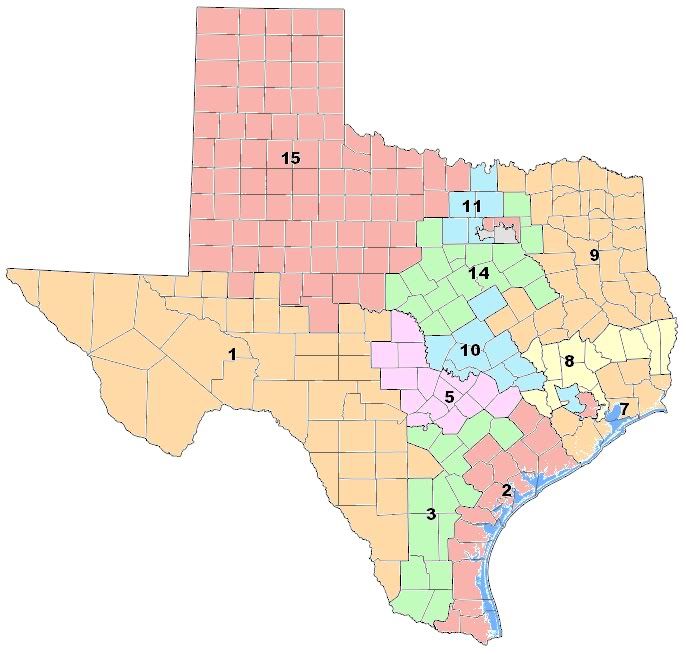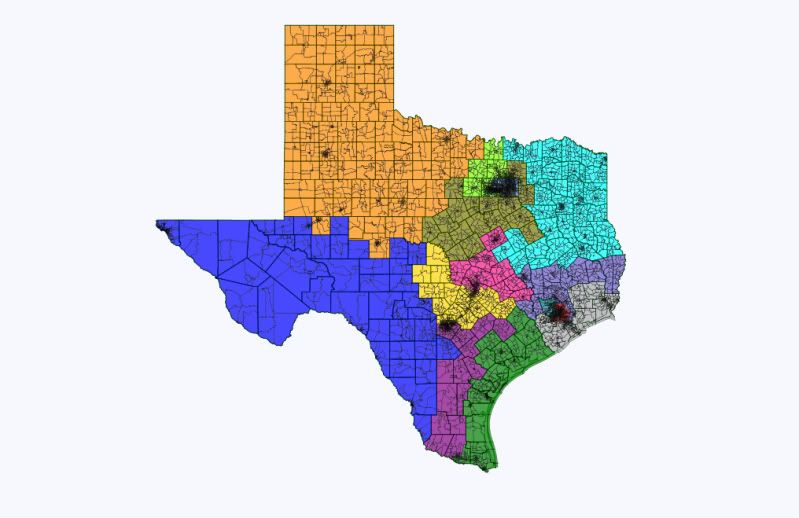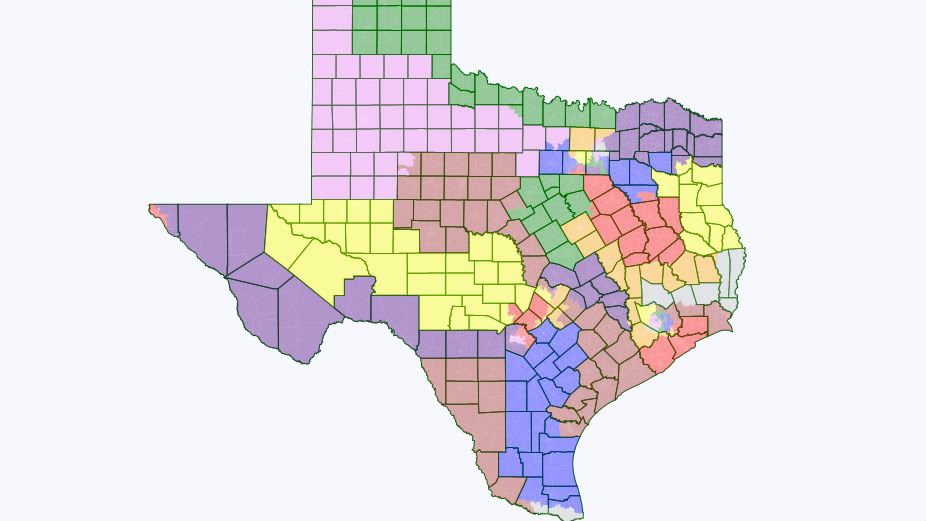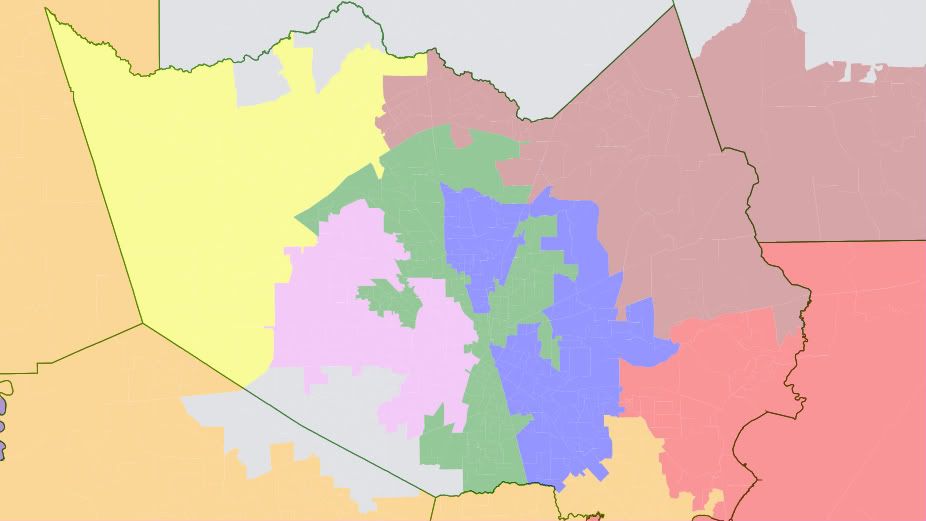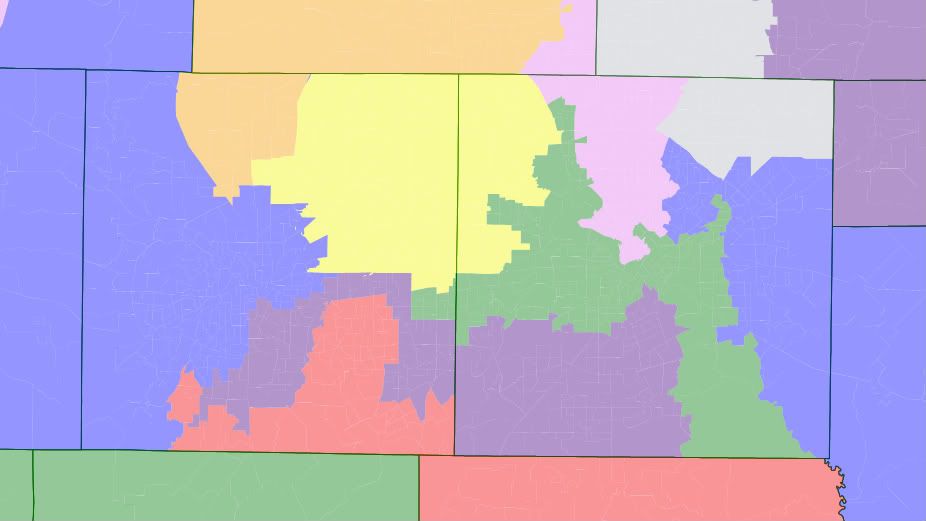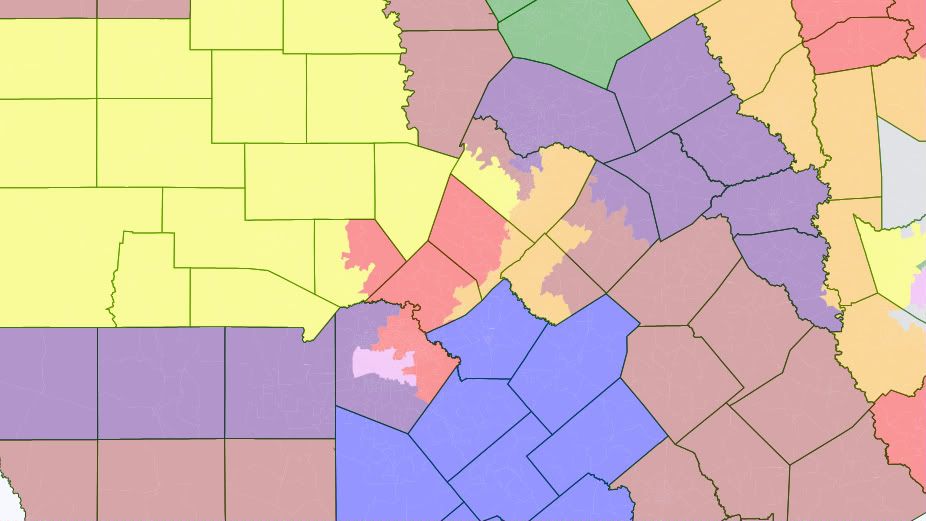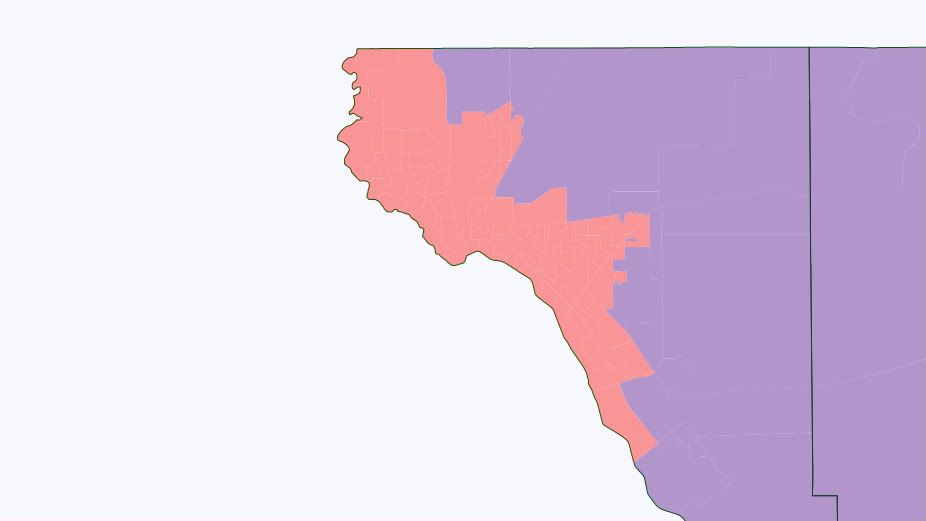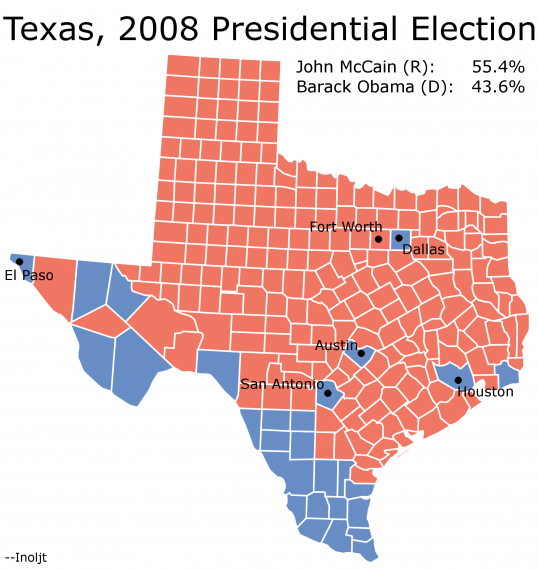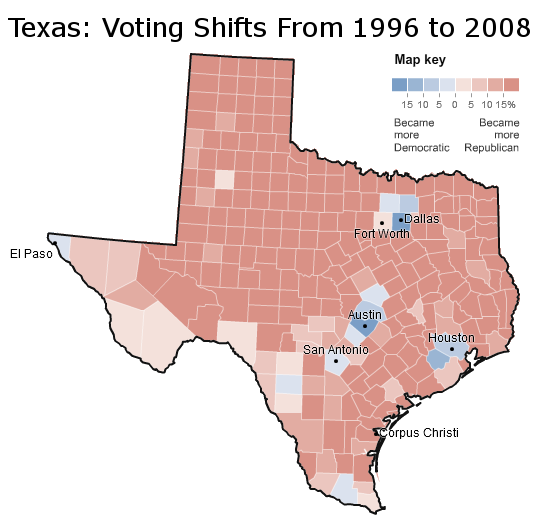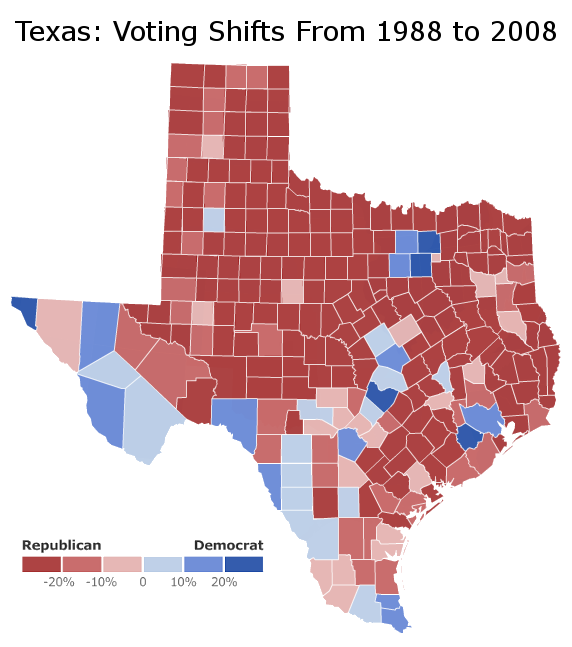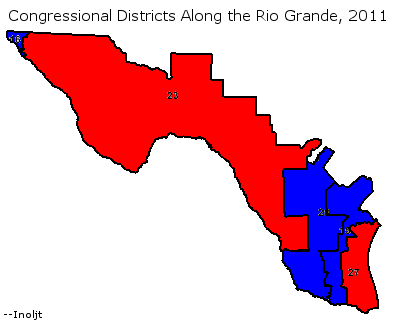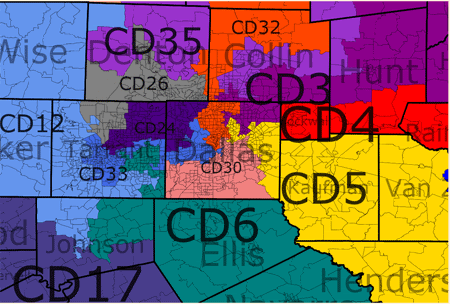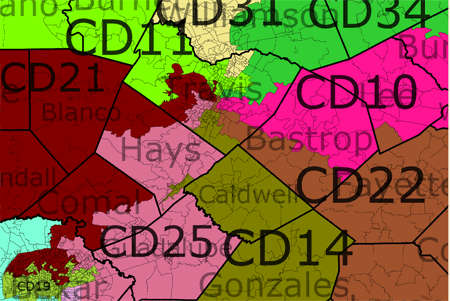Now that Dave has uploaded Census data for Texas, I thought I’d give one of the most interesting states this decade a go on his website. There are ups and downs re: the realism of this map. Of the four new seats, I made one new heavily Democratic VRA seat in Dallas-Fort Worth meant to elect an Hispanic (though that % is still under 60), one competitive South Texas seat that is majority but not safely Hispanic (again, under 60%), and overwhelmingly Republican seats in north Houston and — not sure how to describe this region — between Weatherford/Fort Worth in the north and Killeen in the south. As for protecting Republican incumbents, the new GOP Houston seat made it harder for me to help Mike McCaul, whose district barely voted for McCain, and the Hispanic boom in San Antonio can only hurt Quico Canseco (though a better mapmaker than I could have split the difference with Lamar Smith to help Canseco’s reelection chances). But overall, this is a decent map. Take a look below the fold…

RURAL EAST TEXAS: 3 Republicans
District 1 (brown)
Representative: Louie Gohmert (R)
Areas: Tyler, East
Demographics: 70% white
2008 Vote: McCain 69-31
Gohmert stays safe and this seat barely changes.
District 4 (red)
Representative: Ralph Hall (R)
Areas: Rockwall, Texarkana
Demographics: 80% white
2008 Vote: McCain 69-30
Sheds some suburban population but remains similarly situated.
District 8 (lavender)
Representative: Kevin Brady (R)
Areas: Montgomery County, Southeast
Demographics: 80% white
2008 Vote: McCain 74-25
The most densely populated spots in Montgomery County are ceded to the new District 35 in northwest Houston, but this district’s general shape stays the same. It remains among the wealthiest and most Republican seats in the state.
HOUSTON AND SOUTHEAST: 5 Republicans, 3 Democrats

District 2 (green)
Representative: Ted Poe (R)
Areas: Humble, Port Arthur
Demographics: 63% white
2008 Vote: McCain 57-42
Cedes parts of Jefferson County to Ron Paul and northern Harris County to the new District 35.
District 7 (gray)
Representative: John Culberson (R)
Areas: west Houston
Demographics: 67% white
2008 Vote: McCain 57-42
Contracts a bit in area and moves slightly south and east, but stays fairly Republican for near-downtown Houston.
District 9 (turquoise)
Representative: Al Green (D)
Areas: south Houston, north Fort Bend
Demographics: 39% black, 33% Hispanic, 17% white
2008 Vote: Obama 78-22
Surprisingly, I was able to keep black pluralities both here and in District 18 despite the Hispanic population explosion of the last decade.
District 14 (olive)
Representative: Ron Paul (R)
Areas: Galveston, Lake Jackson
Demographics: 65% white
2008 Vote: McCain 63-36
Paul’s district shrinks and becomes even more coastal but stays securely Republican. It still amazes me that a downright libertarian continues to get elected in military-heavy country like southeast Texas.
District 18 (yellow)
Representative: Sheila Jackson Lee (D)
Areas: central Houston
Demographics: 44% black, 34% Hispanic, 17% white
2008 Vote: Obama 80-19
The most Democratic district in Texas remains so, changing only to accommodate population growth.
District 22 (brown)
Representative: Pete Olson (R)
Areas: Sugar Land, Missouri City, Pasadena
Demographics: 57% white (20% Hispanic, 13% Asian – future VRA seat?)
2008 Vote: McCain 58-42
Welcome to the district most likely to become majority-minority during the 2010s. Tom DeLay’s old turf remains Republican enough — slightly more so than the state at large, in fact — but in 2021 we are probably looking at a new VRA district right here.
District 29 (light green)
Representative: Gene Green (D)
Areas: east Houston
Demographics: 69% Hispanic
2008 Vote: Obama 63-37
Green has managed 20 years as an Anglo Congressman for Houston’s Hispanic-majority district, but as the Latino population reaches South Texas levels, can he withstand a primary challenge? Given his seniority, most think so, but GOP mapmakers may try to concentrate Hispanics previously represented by Sheila Jackson Lee or Al Green to mess with him.
District 35 (purple)
Representative: TBD
Areas: northwest Houston, Conroe, south-central
Demographics: 72% white
2008 Vote: McCain 67-33
I made this district too Republican, at the expenses of Mike McCaul, John Culberson, and Ted Poe. A professional gerrymanderer could do better. Regardless, legislators will make a safe GOP seat in north Houston.
DALLAS-FORT WORTH: 7 Republicans, 2 Democrats

District 3 (fuchsia-purple)
Representative: Sam Johnson (R)
Areas: Plano
Demographics: 76% white
2008 Vote: McCain 61-38
Huge growth in the Metroplex suburbs means this district is now confined to Collin County.
District 5 (yellow)
Representative: Jeb Hensarling (R)
Areas: Mesquite, east-central
Demographics: 74% white
2008 Vote: McCain 64-35
I’m not sure if Hensarling still lives here, as Districts 30 and 32 both ate up some white areas of north Dallas, but he would move here if need be as this district is quite solid for a Dallas County Republican.
District 6 (teal)
Representative: Joe Barton (R)
Areas: Arlington, east-central
Demographics: 67% white
2008 Vote: McCain 60-39
The former Energy and Commerce Committee chairman remains quite safe in this meandering Arlington-to-rural-East-Texas seat.
District 12 (blue-gray)
Representative: Kay Granger (R)
Areas: Fort Worth
Demographics: 69% white
2008 Vote: McCain 57-42
Now entirely within Tarrant County, this district loses its rural areas but stays fairly Republican. As the Metroplex trends more Democratic, this may become competitive by 2020.
District 24 (dark purple)
Representative: Kenny Marchant (R)
Areas: Carrollton, Irving, Grapevine
Demographics: 65% white
2008 Vote: McCain 58-41
This fast-growing seat may also become a tossup in the next decade, though it remains affluent, suburban, and decidedly Republican.
District 26 (pink)
Representative: Mike Burgess (R)
Areas: Denton County
Demographics: 81% white
2008 Vote: McCain 66-34
I maintained the odd “dripping” shape of this district; in fact, this is one of the least changed seats in the state (in addition to the whitest).
District 30 (peach)
Representative: Eddie Bernice Johnson (D)
Areas: central and south Dallas
Demographics: 45% black, 28% white, 25% Hispanic
2008 Vote: Obama 79-20
As District 32 moved east, toward Richardson and Garland and away from white-flight Dallas proper, Johnson had to pick up some white areas of north Dallas, though Democratic primaries in the district will still be dominated by African-Americans.
District 32 (orange)
Representative: Pete Sessions (R)
Areas: north Dallas, Garland
Demographics: 62% white
2008 Vote: McCain 55-44
A rapidly diversifying area, this district may be unsalvageable for Republicans in ten years, but for now I did my best to help Sessions (who might not live here) and future area GOPers.
District 36 (gold)
Representative: TBD
Areas: urban Fort Worth-to-Dallas serpent
Demographics: 58% Hispanic, 20% white, 19% black
2008 Vote: Obama 74-25
Republicans really do not have a choice anymore; they must draw a second Democratic vote-sink in the Metroplex, and almost everyone expects it to be a VRA coalition or Hispanic-majority district linking the region’s two primary cities. Low Hispanic turnout might enable a white or black Democrat to win, but any serious primary candidate will need to have ties to the Latino community, at least.
CENTRAL TEXAS: 5 Republicans, 1 Democrat
District 10 (pink)
Representative: Mike McCaul (R)
Areas: northeast Austin, Brazos Valley
Demographics: 63% white
2008 Vote: McCain 50-48
My biggest regret in this map is failing to give McCaul a safe district; he had to lose safe GOP areas of Harris County to enable the creation of a new district around Houston and these were replaced with counties east of Austin that are no more Republican. Again, a more skilled mapmaker can split the difference between this and District 35 to make two safe GOP seats.
District 17 (ash purple/puce)
Representative: Bill Flores (R)
Areas: stretches down to Waco, Temple, College Station
Demographics: 65% white
2008 Vote: McCain 62-37
This once-important district (back when unhinging Chet Edwards was a priority for state Republicans) is now little more than a “leftovers” seat sandwiched between fast-growing seats like the 8th, 10th, and 31st (in addition to the new District 34).
District 25 (salmon pink)
Representative: Lloyd Doggett (D)
Areas: Austin, San Marcos
Demographics: 52% white, 33% Hispanic
2008 Vote: Obama 67-32
Much as Republicans would like to crack Austin’s Democratic base, growing Dem strength in Central Texas is sufficient for them to make a compact, geographically logical seat for Doggett.
District 31 (weak yellow)
Representative: John Carter (R)
Areas: Round Rock, New Braunfels
Demographics: 77% white
2008 Vote: McCain 57-41
Carter’s district had to move south to accommodate the new District 34 and, even then, it contracted considerably in area.
District 34 (green)
Representative: TBD
Areas: Weatherford and Arlington all the way down to Killeen
Demographics: 75% white
2008 Vote: McCain 67-32
Now here’s a classic DeLaymander-style district: it stretches incoherently from the Metroplex in the north down to the heart of Central Texas. In any case, it’s safely Republican, maybe enough so that Carter should be further shored up at its expense.
WEST TEXAS: 3 Republicans
District 11 (lime)
Representative: Mike Conaway (R)
Areas: Midland, San Angelo
Demographics: 65% white
2008 Vote: McCain 75-24
This is actually the least altered district in the state, I believe.
District 13 (light brown)
Representative: Mac Thornberry (R)
Areas: Panhandle, Amarillo
Demographics: 76% white
2008 Vote: McCain 77-22
Actually extends into what used to be Kay Granger land to get enough population.
District 19 (chartreuse)
Representative: Randy Neugebauer (R)
Areas: Lubbock, Abilene
Demographics: 64% white
2008 Vote: McCain 72-28
Now looks slightly less silly on its pinched southern flank.
SAN ANTONIO, EL PASO, & SOUTH TEXAS: 4 Democrats, 3 Republicans, 1 competitive
District 15 (orange)
Representative: Ruben Hinojosa (D)
Areas: Victoria down to the Mexican border
Demographics: 72% Hispanic
2008 Vote: Obama 53-46
The first of the “fajita strip” districts intended to maximize Hispanic strength in the Rio Grande Valley. It could still afford to shed a few Latinos to the new District 33, whose Hispanic majority is less than secure for VRA purposes.
District 16 (green)
Representative: Silvestre Reyes (D)
Areas: El Paso
Demographics: 76% Hispanic
2008 Vote: Obama 65-34
This district has essentially been urban El Paso for all of contemporary Texas history.
District 20 (pink)
Representative: Charlie Gonzalez (D)
Areas: San Antonio
Demographics: 68% Hispanic
2008 Vote: Obama 64-35
Much like the 16th, this is a compact urban seat.
District 21 (brown)
Representative: Lamar Smith (R)
Areas: north San Antonio, Hill Country
Demographics: 68% white
2008 Vote: McCain 64-35
Smith remains safe; maybe too safe. But I’m not sure how to transfer significant numbers of Republicans from his district to Canseco’s without begging for a VRA lawsuit.
District 23 (light green)
Representative: Quico Canseco (R)
Areas: between El Paso and south San Antonio
Demographics: 69% Hispanic
2008 Vote: Obama 57-42
This actually got significantly more Democratic, much to my dismay as someone hoping to craft a realistic GOP map. I suppose I could have kept north San Antonio in the district, but the 21st would have become pretty awkward-looking. Still, Republicans will probably do just that.
District 27 (shiny green)
Representative: Blake Farenthold (R)
Areas: coast down to Brownsville
Demographics: 67% Hispanic
2008 Vote: Obama 52-47
From Farenthold’s perspective, this district is no worse than his current one, but if I were him I’d move into the new District 33 (if he doesn’t already live there), which is significantly whiter and slightly more Republican.
District 28 (mauve)
Representative: Henry Cuellar (D)
Areas: east San Antonio down to Mexican border
Demographics: 73% Hispanic
2008 Vote: Obama 60-40
This is a pear-shaped seat now, with a pinched San Antonio and Seguin top and a robust bottom. Again, I could have diluted its and the 15th’s Hispanic pops to make the 33rd closer to safety from otherwise inevitable lawsuits. But hey, at least Laredo is in one district!
District 33 (periwinkle)
Representative: TBD
Areas: Fort Bend County down to Harlingen
Demographics: 58% Hispanic, 35% white
2008 Vote: McCain 51-49
No one will like this district. It’s ugly, geographically incoherent (Houston exurbs and border towns?), not Hispanic enough to avoid a lawsuit, and politically competitive (likely Democratic in a year like 2008 and Republican in a year like 2010). This seat is an unfortunate product of big population growth both in Fort Bend County and the Rio Grande Valley. Again, mapmakers will almost surely come up with a more elegant solution than this.
OVERALL
Texas has twelve VRA-protected districts in this scenario. As I said, there are areas in which I overconcentrated Republicans and would like to spread them thinner to help potentially endangered GOP incumbents. At other times, my districts are just plain fugly. But in general, the map we see from Texas should vaguely resemble this, with a new Dem VRA seat in Dallas, a new GOP seat in Houston, a new GOP seat in Central, and a new Hispanic VRA seat in South Texas that may lean Democratic, but will not be overwhelmingly so.
